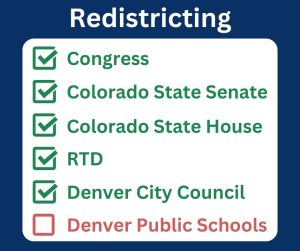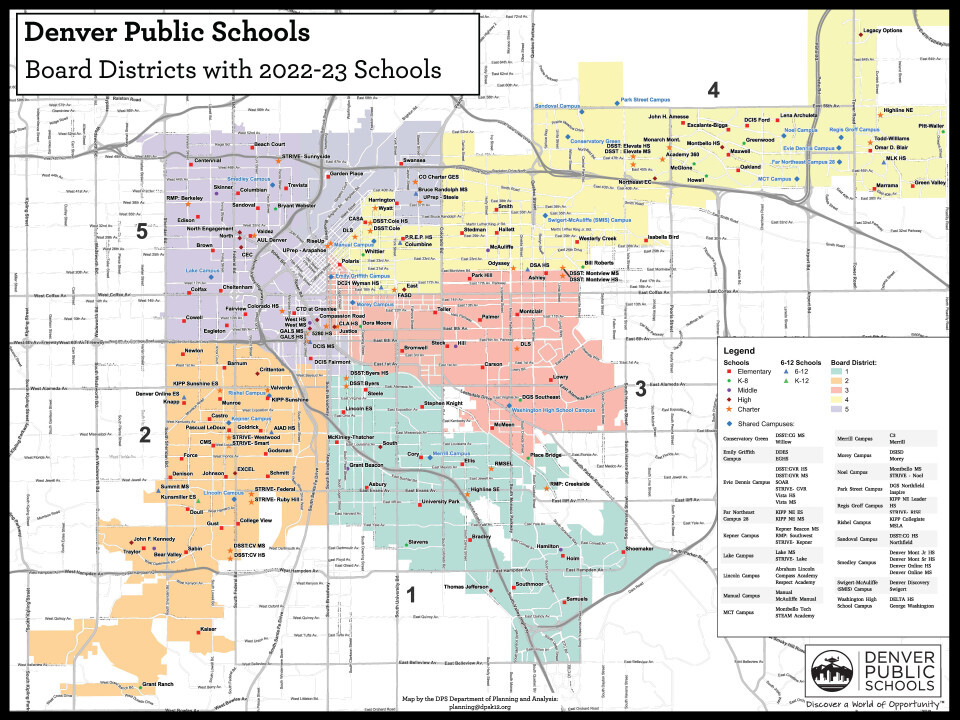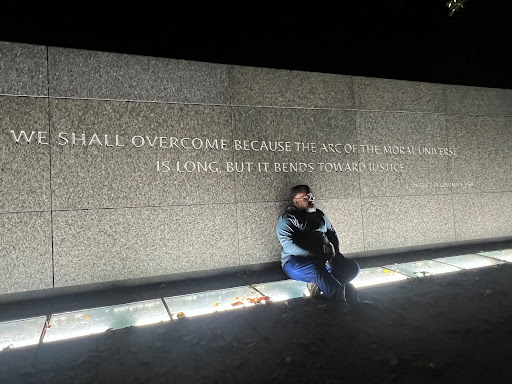Editor’s note: This is the inaugural piece by new Boardhawk columnist Alexis Menocal Harrigan.
The new year brings retrospection. What have we done well, where did we fall short, and how can we be a little better in the year ahead?
The Denver Public Schools board has given us plenty of opportunities to highlight where it fell short in 2023, and for many of us, the high point of the year was the election of three new board members. What can the board do to be a little better in the year ahead?
Allow me to make a case for redistricting.
Redistricting isn’t simply about moving some lines on a map, it is a cornerstone of equal representation under the law.
Denver’s communities of color have long been concentrated into culturally rich pockets of our city. Denverites have tremendous pride in the cultural character of their respective geographic ‘hoods. You can spot a longtime Denverite who knew the city pre-21st century gentrification if they proudly claim to be an Eastsider, Northsider, or Westsider.
Redistricting, in theory, should provide fair and equal representation for everyone, and DPS director districts are no exception. The DPS board adopted Guiding Principles for Redistricting, when they last redrew the boundaries in 2014. The principles align to legal requirements and include:
- Balance total population (representation, one person one vote)
- Maintain minimal impact on racial/ethnic concentrations (voting rights act, equal protections clause, avoid dilution of minority vote)
- Minimize the number of impacted families as a result of the process
 Diluting the voting power of communities of color has been a systemic tool of oppression. Denver is fortunate to have had activists and civic leaders of influence champion voting rights over the last half century. As a result, we often elect Latinos up and down the Northwest and West side of our city and African Americans in the near and far-Northeast.
Diluting the voting power of communities of color has been a systemic tool of oppression. Denver is fortunate to have had activists and civic leaders of influence champion voting rights over the last half century. As a result, we often elect Latinos up and down the Northwest and West side of our city and African Americans in the near and far-Northeast.
It is easy to take this for granted in 2024, but let’s not forget that attempts at voter suppression will be taking place across the country over the next 11 months leading up to the presidential election. The last DPS board was lazy and apathetic about this issue, choosing inaction and further proving its ineffectiveness as a governing body.
Denver’s population grew by nearly 20 percent from 2010 and 2020. That growth was not equal and we now have a larger DPS director district population in Northwest Denver and a shrinking population in Southwest Denver.
The longer the DPS board allows unbalanced voting districts to continue, the more we risk eroding democratic process, and undermining voter confidence and representation.
Why the delay?
You may be wondering why we are four years from the 2020 census and still don’t have new DPS districts? During a September 2022 board meeting, staff had proposed a process timeline ending with a February 2023 vote on new maps. In the fall of 2022, DPS conducted a community engagement process for redistricting.
February came and went without a vote. Citing low community engagement, the board debated delaying redistricting during a March special board meeting. At that meeting, DPS staff explained the possible legal risk of knowingly allowing elections to run with districts out of balance.
There are 37,000 more voters in District 4 (Northeast Denver) than in District 2 (Southwest Denver). For my constitutional redistricting friends, that is a population deviation of 23%. Districts 4 and 2 did not have seats up for election in November 2023, possibly providing some defense if DPS were sued for violating the Equal Protection Clause under the 14th Amendment.
There is no deadline for when the board must complete redistricting. Despite this indefinite timeline, DPS legal counsel Aaron Thompson expressed his concern about delaying three years. He also acknowledged that violation of the statute for unreasonable delay would be left up to the courts to determine, and that “the longer we wait, the less reasonable the board becomes.”
We are now 10 months past that board meeting, and almost four years out from the 2020 census. So, is four years reasonable? The last DPS redistricting also happened four years after the 2010 census. To that argument, Thompson retorted, “Doesn’t make it the right thing to do,” and I completely agree.
Ultimately, the board chose to do the bare minimum; align board districts to have whole precincts, but they did not redistrict. This decision likely impacted a few dozen households.
Board ignores city pressure to act
They completed re-precincting after receiving a strongly worded letter from Clerk and Recorder Paul López. Lopez went on to express his concerns, and the possible impacts if the district postpones full redistricting.
Despite Denver’s chief election official’s request to take action ASAP, the board chose not to act and continued to delay redistricting.
The legal term for the board’s delay last year is unreasonable. This critic’s word is arrogance.
While legal scholars can debate the legality of their inaction, the rest of us should be concerned with board members’ blatant disregard for democratic values. The previous board claimed community engagement was a prime reason for the delay, but we are nearly a year later and there has been little if any community process.
DPS is not exempt from one person, one vote. Other redistricting bodies were able to approve their maps under larger political microscopes. For comparison, Colorado’s legislative redistricting commissions submitted congressional and legislative maps in September 2021, with the state Supreme Court approving the maps in November of 2021. Denver City Council and RTD both approved new maps in March 2022.
This new board is attempting to differentiate itself from its previous dysfunctional one. This is an opportunity to prove board members can work together and put their egos aside to accomplish a goal for the benefit of DPS students and families.
Best of all, last I checked, fair representation doesn’t fall on one side of the Denver education debate. To expedite redistricting, the board needs to create a process, timeline, and deadline for approving final maps.
Addressing redistricting is a reasonable and doable action item for the board to address in the first half of 2024. Fair and equitable community engagement will still be an important aspect of this process, and likely now more than ever.
The same statute (22-31-109) that regulates redistricting requirements also regulates the minimum and maximum number of director districts. Legislators and DPS activists are currently reevaluating the statute to increase the number of board seats beyond the current seven-director limit.
While they are editing the statute, it would be easy to create more guidance on redistricting, especially if the legislators at the Capitol look three blocks north to DPS headquarters and see further delays and disregard for one person one vote. Further guidance could mean creating timelines and establishing a process for community engagement. If the DPS board fumbles on redistricting again, the legislature may step in and attempt to force changes to director districts.
I am usually hopeful in the new year, and 2024 is no exception. I am hopeful that this newly formed board will be able to work together and build an equitable and expedited process to ensure DPS voters have fair representation.




